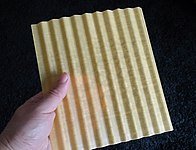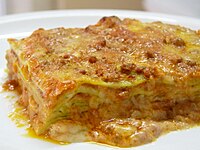Lasagna
 Lasagne al forno | |
| Alternative names | Lasagne |
|---|---|
| Type | Pasta |
| Course | Primo (Italian course) or main |
| Place of origin | Italy |
| Region or state | Emilia-Romagna |
| Serving temperature | Hot |
| Main ingredients | Wheat, ground meat, cheese |
| Variations | Lasagnette and lasagnotte |
Lasagna (UK: /ləˈzænjə/,[1] US: /ləˈzɑːnjə/, Italian: [laˈzaɲɲa]), also known as lasagne (Italian: [laˈzaɲɲe]), is a type of pasta, possibly one of the oldest types,[2] made in very wide, flat sheets. In Italian cuisine it is made of stacked layers of pasta alternating with fillings such as ragù (ground meats and tomato sauce), béchamel sauce, vegetables, cheeses (which may include ricotta, mozzarella, and Parmesan), and seasonings and spices.[3] The dish may be topped with grated cheese, which melts during baking. Typically cooked pasta is assembled with the other ingredients and then baked in an oven (al forno). The resulting baked pasta is cut into single-serving square or rectangular portions.
Etymology
In ancient Rome, there was a dish similar to a traditional lasagna called lasana or lasanum (Latin for 'container' or 'pot') described in the book De re coquinaria by Marcus Gavius Apicius,[4] but the word could have a more ancient origin. The first theory is that lasagna comes from Greek λάγανον (laganon), a flat sheet of pasta dough cut into strips.[5][6][7][8] The word λαγάνα (lagana) is still used in Greek to mean a flat thin type of unleavened bread baked for the Clean Monday holiday.
Another theory is that the word lasagna comes from the Greek λάσανα (lasana) or λάσανον (lasanon) meaning 'trivet', 'stand for a pot' or 'chamber pot'.[9][10][11] The Romans borrowed the word as lasanum, meaning 'cooking pot'.[12] The Italians used the word to refer to the cookware in which lasagna is made. Later the food took on the name of the serving dish.
Another proposed link or reference is the 14th-century English dish loseyn[13] as described in The Forme of Cury, a cookbook prepared by "the chief Master Cooks of King Richard II",[14] which included English recipes as well as dishes influenced by Spanish, French, Italian, and Arab cuisines.[15] This dish has similarities to modern lasagna in both its recipe, which features a layering of ingredients between pasta sheets, and its name. An important difference is the lack of tomatoes, which did not arrive in Europe until after Columbus reached the Americas in 1492. The earliest discussion of the tomato in European literature appeared in a herbal written in 1544 by Pietro Andrea Mattioli,[16] while the earliest cookbook found with tomato recipes was published in Naples in 1692, but the author had obtained these recipes from Spanish sources.[16]
As with most other types of pasta, the Italian word is a plural form: lasagne meaning more than one sheet of lasagna, although, in many other languages, a derivative of the singular word lasagna is used for the popular baked pasta dish. When referring to the baked dish, regional usage in Italy favours the plural form lasagne in the north of the country and the singular lasagna in the south.[17] The former plural usage has influenced the usual spelling found in British English, while the southern Italian singular usage has influenced the spelling often used in American English.[17] Both lasagna and lasagne are used as singular non-count (uncountable) nouns in English.[18]
Origins and history
Lasagna originated in Italy during the Middle Ages. The oldest transcribed text about lasagna appears in 1282 in the Memoriali Bolognesi ('Bolognese Memorials'), in which lasagna was mentioned in a poem transcribed by a Bolognese notary;[19][20] while the first recorded recipe was set down in the early 14th century in the Liber de Coquina (The Book of Cookery).[21] It bore only a slight resemblance to the later traditional form of lasagna, featuring a fermented dough flattened into thin sheets, boiled, sprinkled with cheese and spices, and then eaten with a small pointed stick.[22] Recipes written in the century following the Liber de Coquina recommended boiling the pasta in chicken broth and dressing it with cheese and chicken fat. In a recipe adapted for the Lenten fast, walnuts were recommended.[22]
Variations
Pasta
Mass-produced lasagne with a ruffled edge is called lasagna riccia, doppio festone, sciabò, and sciablò.[23] In the Veneto, factory-produced lasagne are called bardele or lasagnoni.[23] Narrower lasagne are mezze lasagne, and if with a ruffled edge, mezze lasagne ricche.[23] Similar pastas are the narrower lasagnette and its longer cousin, the lasagnotte (cappellasci [sic] in Liguria[23][24]), as well as the sagne of Salento (the "heel" of the Italian "boot"),[23] and lagana in the remainder of Apulia.[23]
Dish

The lasagna of Naples, lasagne di carnevale, is layered with local sausage, small fried meatballs, hard-boiled eggs, ricotta and mozzarella cheeses, and sauced with Neapolitan ragù, a meat sauce.[25]
Lasagne al forno, layered with a thicker ragù and béchamel sauce and corresponding to the most common version of the dish outside Italy, is traditionally associated with the Emilia-Romagna region of Italy. Here, and especially in its capital, Bologna, layers of lasagna are traditionally green (the colour is obtained by mixing spinach or other vegetables into the dough)[26] and served with ragù (a thick sauce made with onions, carrots, celery, finely ground pork and beef, butter, and tomatoes),[27][28] béchamel sauce, and Parmesan cheese.
In other regions, lasagna can be made with various combinations of ricotta or mozzarella, tomato sauce, meats (such as ground beef, pork, veal or chicken), and vegetables (such as spinach, zucchini, olives, and mushrooms), and the dish is typically flavoured with wine, garlic, onion, and oregano. In all cases, the lasagne are baked (al forno).
Traditionally, pasta dough prepared in southern Italy used semolina and water; in the northern regions, where semolina was not available, flour and eggs were used. In modern Italy, since the only type of wheat allowed for commercially sold pasta is durum wheat, industrial lasagne are made from durum wheat semolina.[29] Nonetheless, in the north and especially in Emilia-Romagna, the tradition of egg-based dough remains popular for artisanal and homemade productions.[citation needed]
Gallery
-
Flat sheets of lasagna before cooking
-
Lasagna with ruffled edges
-
Completely ridged lasagna
-
Green lasagna (made with spinach in the dough), with ragù, Parmesan, and béchamel sauce, typical of Bolognese cuisine
See also
![]() Media related to Lasagne (layered dish) at Wikimedia Commons
Media related to Lasagne (layered dish) at Wikimedia Commons
![]() Lasagne at the Wikibooks Cookbook subproject
Lasagne at the Wikibooks Cookbook subproject
- List of pasta
- List of pasta dishes
- List of casserole dishes
- Baked ziti – a baked Italian dish with macaroni and sauce
- Casserole
- Crozets de Savoie – a type of small, square-shaped pasta made in the Savoie region in France
- Lasagna cell – inadvertent corrosion caused by improper storage of lasagna
- Lasagnette – a narrower form of the pasta
- Lasagnotte
- Lazanki – a type of small square- or rectangle-shaped pasta made in Poland and Belarus
- Moussaka – a Mediterranean casserole that is layered in some recipes
- Oreilles d'âne – a French Alpine casserole made with lasagna and wild spinach
- Pastelón – a baked, layered Puerto Rican dish made with plantains
- Pastitsio – a baked, layered Mediterranean pasta dish
- Timballo – an Italian casserole
References
- ^ The Oxford English Dictionary. Oxford University Press.
- ^ The Oxford Companion to Food 2nd Ed. Oxford University Press, USA. 2006. ISBN 0-19-280681-5.
- ^ "Lasagna". Merriam-Webster. Retrieved 30 June 2017.
- ^ De re coquinaria. Apicio.
- ^ λάγανον, Henry George Liddell, Robert Scott, A Greek-English Lexicon, on Perseus.
- ^ Dalby, Andrew (2003). Food in the ancient world from A to Z. London: Routledge. ISBN 9780415232593. OCLC 892612150.
- ^ "Everyone Eats: Understanding Food and Culture", Eugene Newton Anderson, NYU Press, 2005.
- ^ "The Origins of pasta". The Real Italian Pasta. Archived from the original on 22 July 2011. Retrieved 10 March 2017.
- ^ λάσανα, Henry George Liddell, Robert Scott, A Greek-English Lexicon, on Perseus.
- ^ Muhlke, Christine (2 April 1997), "A Lighthearted Look at How Foods Got Their Names", Cookbook Shelf:Book Review, Salon.com, archived from the original on 8 August 2007, retrieved 30 September 2007.
- ^ "lasagna". Merriam-Webster's Online Dictionary. Retrieved 10 March 2017.
- ^ Lewis, Charlton T.; Short, Charles. "lăsănum". A Latin Dictionary. Perseus Digital Library. Retrieved 10 March 2017.
- ^ "Loseyns (Lozenges)". Celtnet. Dyfed Lloyd Evans. Archived from the original on 5 December 2012. Retrieved 24 March 2012.
- ^ John Rylands University Library of Manchester (1996). Things sweet to taste: selections from the Forme of cury: a fourteenth-century cookery book in the John Rylands Library. John Rylands Library. ISBN 0863731341. OCLC 643512620.
Thys fourme of cury ys compyled of þe mayster cokes of kyng Richard þe secund ... by assent of Maysters of physik and of phylosophye.
- ^ Bouchut, Marie Josèphe Moncorgé; Bailey, Ian (trans.); Hunt, Leah (trans.). "Oldcook: Forme of Cury and cookery books in English". Retrieved 24 August 2016.
- ^ a b Smith, Andrew F. (1994). The tomato in America: early history, culture, and cookery. Columbia, S.C, USA: University of South Carolina Press. ISBN 1-57003-000-6.
- ^ a b Buccini, A. F. (2013). "Lasagne, a layered history". In McWilliams (ed.). Wrapped & Stuffed Foods: Proceedings of the Oxford Symposium on Food and Cookery. Prospect. p. 95. ISBN 9781903018996.
... in referring to baked versions of the dish, regional usage in Italy favours the plural form lasagne in the north and the singular form lasagna in the south; from the former usage stems the British use of 'lasagne' and from the latter the American 'lasagna'. Neither usage can be considered 'more correct' ....
- ^ Laurie Bauer, Rochelle Lieber and Ingo Plag. The Oxford Reference Guide to English Morphology. Oxford University Press, 2015. p. 139. ISBN 9780198747062.
- ^ Un mare magnum di possibilità: i Memoriali bolognesi e la loro schedatura (1265-1452)
- ^ Rime dei memoriali bolognesi
- ^ Liber de Coquina (1285), De lasanis Archived 12 February 2015 at the Wayback Machine. Gloning.
- ^ a b Serventi, Pasta: the story of a universal food, Columbia UP, 2012, p. 235.
- ^ a b c d e f Oretta Zanini De Vita. Encyclopedia of Pasta. University of California Press, 2019. p. 148. ISBN 9780520322752.
- ^ Gaetano Frisoni. "Cappellasci" entry in Dizionario moderno genovese-italiano e italiano-genovese. A. Donath, 1910. p. 65.
- ^ Del Conte, Anna (1 December 2013). Gastronomy of Italy. Pavilion. ISBN 978-1862059580.
- ^ "Lasagne – die Teigplatte" (in German). Retrieved 24 August 2021.
- ^ Hess, Reinhardt; Sälzer, Sabine (1999). Regional Italian cuisine: typical recipes and culinary impressions from all regions. Barron's. ISBN 9780764151590. OCLC 42786762.
- ^ Root, Waverley. The Cooking of Italy. New York: Time-Life, 1968. Print.
- ^ "Decreto del Presidente della Repubblica n. 187" [Presidential Decree n. 187] (PDF). Gazzetta Ufficiale della Repubblica Italiana (in Italian). 117: 5. 9 February 2021. Archived (PDF) from the original on 18 June 2022. Retrieved 22 June 2022 – via translation by Union of the Organizations of Manufacturers of Pasta Products in the E.U.
Further reading
- Sagon, Candy (16 February 2000). "The Americanization Of Lasagna". The Washington Post. p. F01. Retrieved 24 November 2021.




